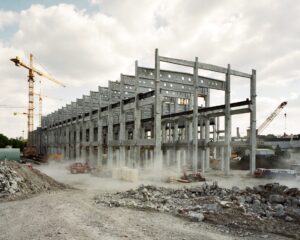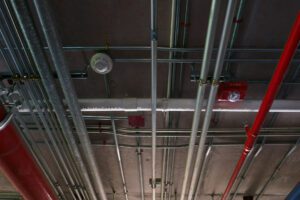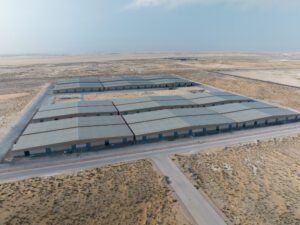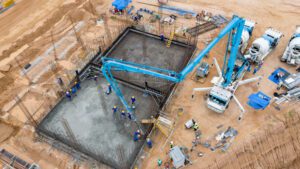Building Warehouses in Saudi Arabia: A Comprehensive Guide to Construction Contracting
Book Chapters:
Introduction to Warehouses in Saudi Arabia
Understanding Warehouse Construction Contracting
Building Regulations and Standards in KSA
Site Selection and Preparation
Pre-Construction Planning and Design
Project Management and Budgeting
Building Materials and Equipment Selection
Concrete and Masonry Work
Steel Structures and Framing
Electrical and Plumbing Systems
HVAC and Fire Protection Systems
Interior Finishing and Design
Warehouse Security and Safety
Sustainability and Green Building Practices
Post-Construction Maintenance and Upkeep
Book Introduction:
Building Warehouses in Saudi Arabia: A Comprehensive Guide to Construction Contracting is a practical guidebook for anyone interested in the construction contracting of warehouses in the Kingdom of Saudi Arabia. This book is designed to help developers, contractors, and project managers navigate the complex process of building a warehouse in KSA, from pre-construction planning and design to post-construction maintenance and upkeep.
Saudi Arabia is a country with a rapidly growing economy, and as a result, the demand for warehousing and logistics services is on the rise. Building a warehouse in Saudi Arabia can be a lucrative investment, but it is also a complex process that requires a comprehensive understanding of local regulations, standards, and construction practices.
This book provides a comprehensive overview of the construction contracting process for building warehouses in Saudi Arabia. It covers everything from site selection and preparation to post-construction maintenance and upkeep, with a focus on project management, budgeting, and building materials and equipment selection.
Whether you are a developer looking to invest in warehousing and logistics services in KSA or a contractor or project manager tasked with building a warehouse in Saudi Arabia, this book is an essential resource for ensuring the success of your project.
Chapter 1: Introduction to Warehouses in Saudi Arabia
Saudi Arabia is a country with a growing economy, and as a result, the demand for warehousing and logistics services is on the rise. A warehouse is a vital component of any supply chain, providing a space for storing, managing, and distributing goods. In KSA, warehouses are used for a variety of purposes, including storage, distribution, manufacturing, and retail.
Warehouses in Saudi Arabia come in different sizes, shapes, and designs, depending on their intended use. Some warehouses are large-scale facilities used for industrial or commercial purposes, while others are smaller facilities used for retail or personal storage.
The construction of warehouses in Saudi Arabia is regulated by the Saudi Arabian Standards Organization (SASO) and the Saudi Building Code. These regulations ensure that warehouses are built to meet high standards of safety, durability, and functionality.
Building a warehouse in Saudi Arabia requires a comprehensive understanding of local regulations, standards, and construction practices. It also requires careful planning and budgeting, as well as a team of experienced professionals to manage the project from start to finish.
Chapter 2: Understanding Warehouse Construction Contracting
Warehouse construction contracting is the process of managing and executing the construction of a warehouse. It involves a wide range of tasks, including site selection, planning, budgeting, design, construction, and post-construction maintenance and upkeep.
The first step in warehouse construction contracting is site selection. A suitable site for a warehouse should be located in an area that is easily accessible to transportation and distribution networks, with sufficient space for the required building size and parking. Other factors to consider when selecting a site include zoning regulations, environmental impact, and proximity to utilities and infrastructure.
Once a site has been selected, the next step is pre-construction planning and design. This includes developing a detailed project plan, budget, and timeline, as well as creating an architectural and engineering design for the warehouse. During this phase, it’s important to consult with local authorities and stakeholders to ensure that the design meets all regulatory requirements and is compatible with the surrounding environment.
After the planning and design phase is complete, the project moves into the construction phase. This involves mobilizing the necessary resources, such as labor, materials, and equipment, and executing the construction of the warehouse. This phase is often the most complex and demanding, requiring effective project management and coordination to ensure that the project is completed on time and within budget.
During the construction phase, it’s important to closely monitor progress and ensure that all work is carried out to the highest standards of quality and safety. Any deviations from the project plan or budget should be promptly addressed and resolved to prevent delays and cost overruns.
Once the warehouse construction is complete, the final step is post-construction maintenance and upkeep. This involves regular inspections, maintenance, and repairs to ensure that the warehouse continues to function properly and remains in good condition. It’s important to have a comprehensive maintenance plan in place to minimize downtime and maximize the longevity of the warehouse.
Warehouse construction contracting is a complex process that requires a high level of expertise and attention to detail. By understanding the various phases of the process and working with experienced professionals, it’s possible to build a high-quality warehouse that meets all regulatory requirements and serves the needs of its users for years to come. Chapter 3: Legal Considerations in Warehouse Construction Contracting
Warehouse construction contracting involves a number of legal considerations that must be carefully managed to ensure that the project is completed successfully and without legal challenges.
One of the most important legal considerations in warehouse construction contracting is compliance with zoning regulations and building codes. These regulations specify the type of structure that can be built in a particular location, as well as the materials and methods that can be used in construction. Failure to comply with these regulations can result in legal penalties, fines, or even the demolition of the structure.
Another important legal consideration is the management of contracts and agreements. Warehouse construction contracting typically involves a range of contracts and agreements between owners, contractors, suppliers, and other parties. It’s important to ensure that these contracts are carefully drafted, reviewed, and executed to minimize the risk of disputes and litigation.
Insurance is also a critical legal consideration in warehouse construction contracting. Builders risk insurance is essential to protect against potential losses during construction, such as damage to the structure or theft of materials. Liability insurance is also necessary to protect against potential lawsuits resulting from accidents or injuries that occur on the construction site.
Labor laws and regulations are another important legal consideration in warehouse construction contracting. Contractors must ensure that they comply with all local and national labor laws, including minimum wage and overtime regulations, as well as health and safety requirements. Failure to comply with these laws can result in legal penalties and damage to the contractor’s reputation.
Finally, environmental regulations are an important legal consideration in warehouse construction contracting. Contractors must comply with local and national regulations governing the use and disposal of hazardous materials, as well as regulations governing the impact of construction on local ecosystems and water sources.
By carefully managing these legal considerations and working with experienced professionals, it’s possible to successfully navigate the legal complexities of warehouse construction contracting and complete the project with minimal legal risks and challenges.
Chapter 4: Project Management in Warehouse Construction Contracting
Warehouse construction contracting requires effective project management to ensure that the project is completed on time, within budget, and to the required standards of quality and safety. Effective project management involves several key steps, including project planning, resource allocation, scheduling, monitoring, and risk management.
Project planning is the first step in effective project management. This involves developing a detailed project plan that outlines the scope of the project, the budget, the timeline, and the resources required. The project plan should also identify any potential risks and mitigation strategies to minimize these risks.
Resource allocation is the next step in effective project management. This involves identifying the labor, materials, and equipment required for the project and allocating these resources to the appropriate tasks. Resource allocation should be based on the project plan and budget, as well as the availability and expertise of the resources.
Scheduling is an important part of effective project management. This involves developing a detailed schedule for the project that identifies the start and end dates of each task and the dependencies between tasks. The schedule should also take into account any potential delays or disruptions and build in contingency time to minimize these risks.
Monitoring is a critical component of effective project management. This involves tracking the progress of the project against the project plan, budget, and schedule and making adjustments as necessary. Monitoring should be done regularly and systematically to identify any deviations from the plan and take corrective action.
Risk management is an essential part of effective project management. This involves identifying potential risks and developing strategies to mitigate these risks. Risk management should be an ongoing process throughout the project, with risks regularly identified, assessed, and mitigated to minimize their impact on the project.
By implementing effective project management strategies, it’s possible to successfully complete warehouse construction contracting projects on time, within budget, and to the required standards of quality and safety. Working with experienced project management professionals can help ensure that these strategies are effectively implemented and that the project is completed successfully.
Chapter 5: Procurement and Supply Chain Management in Warehouse Construction Contracting
Procurement and supply chain management are critical components of warehouse construction contracting. Effective procurement and supply chain management can help ensure that the project is completed on time, within budget, and to the required standards of quality and safety.
The first step in effective procurement and supply chain management is identifying the materials and equipment required for the project. This involves developing a detailed list of materials and equipment and identifying potential suppliers and vendors. The procurement process should also take into account any potential risks and develop strategies to mitigate these risks.
Once the materials and equipment have been identified, the next step is to develop a procurement plan. This plan should outline the procurement process, including the selection of suppliers, the negotiation of contracts, and the delivery of materials and equipment to the construction site. The procurement plan should also identify any potential risks and develop strategies to mitigate these risks.
Supply chain management is another critical component of warehouse construction contracting. This involves managing the flow of materials and equipment from suppliers to the construction site, as well as the management of inventory and logistics. Effective supply chain management can help ensure that materials and equipment are delivered on time and to the required standards of quality and safety.
Another important consideration in procurement and supply chain management is sustainability. Sustainable procurement practices can help minimize the environmental impact of the project and ensure that the project is completed in a socially responsible manner. This can include using environmentally friendly materials, sourcing materials locally, and ensuring that suppliers and vendors comply with ethical and social responsibility standards.
By implementing effective procurement and supply chain management strategies, it’s possible to successfully complete warehouse construction contracting projects on time, within budget, and to the required standards of quality and safety. Working with experienced procurement and supply chain management professionals can help ensure that these strategies are effectively implemented and that the project is completed successfully.
Chapter 6: Safety Management in Warehouse Construction Contracting
Safety management is an essential component of warehouse construction contracting. The construction site can be a dangerous place, and it’s important to ensure that all workers are safe and that the project is completed to the required standards of safety.
The first step in safety management is to develop a safety plan. This plan should identify potential hazards on the construction site and develop strategies to mitigate these hazards. The safety plan should also outline the procedures for responding to accidents and injuries and the responsibilities of all workers with respect to safety.
Training is another critical component of safety management. All workers should receive comprehensive safety training before beginning work on the construction site. This training should cover potential hazards on the site, safety procedures, and the proper use of personal protective equipment (PPE).
Another important consideration in safety management is the use of PPE. All workers should be provided with appropriate PPE, such as hard hats, safety glasses, and steel-toed boots. The use of PPE can help protect workers from potential hazards on the construction site.
Regular safety inspections and audits are also essential for effective safety management. These inspections should be conducted regularly to identify potential hazards and ensure that workers are following safety procedures. Any issues identified during inspections should be addressed immediately to minimize the risk of accidents and injuries.
Finally, effective communication is critical for safety management. All workers should be aware of potential hazards on the construction site and the procedures for responding to accidents and injuries. Communication should be ongoing throughout the project to ensure that all workers are informed of any changes or updates to the safety plan.
By implementing effective safety management strategies, it’s possible to ensure that warehouse construction contracting projects are completed to the required standards of safety. Working with experienced safety management professionals can help ensure that these strategies are effectively implemented and that the project is completed successfully.
Chapter 7: Quality Management in Warehouse Construction Contracting
Quality management is another essential component of warehouse construction contracting. It’s important to ensure that the project is completed to the required standards of quality, and that all materials and equipment meet these standards.
The first step in quality management is to establish quality standards for the project. These standards should be clearly defined and communicated to all workers and contractors involved in the project. Quality standards should cover all aspects of the project, including materials, equipment, construction techniques, and final finishes.
Quality control is another critical component of quality management. This involves monitoring the project to ensure that it meets the required standards of quality. Quality control should be ongoing throughout the project, with regular inspections and audits to identify any issues and address them immediately.
Effective quality management also involves developing a quality assurance plan. This plan should outline the procedures for ensuring that all materials and equipment meet the required standards of quality. It should also identify any potential risks and develop strategies to mitigate these risks.
Another important consideration in quality management is the use of quality assurance and quality control professionals. These professionals have expertise in ensuring that materials and equipment meet the required standards of quality. Working with experienced quality assurance and quality control professionals can help ensure that the project is completed to the required standards of quality.
Finally, effective communication is critical for quality management. All workers and contractors involved in the project should be aware of the quality standards and procedures for ensuring that these standards are met. Communication should be ongoing throughout the project to ensure that all workers are informed of any changes or updates to the quality management plan.
By implementing effective quality management strategies, it’s possible to ensure that warehouse construction contracting projects are completed to the required standards of quality. Working with experienced quality management professionals can help ensure that these strategies are effectively implemented and that the project is completed successfully.
Chapter 8: Risk Management in Warehouse Construction Contracting
Risk management is a critical component of warehouse construction contracting. Construction sites can be inherently risky, and it’s important to identify and mitigate potential risks to ensure the safety of workers and the successful completion of the project.
The first step in risk management is to identify potential risks. This includes identifying hazards on the construction site, as well as risks associated with the project itself. For example, risks may include delays, budget overruns, or equipment failure.
Once potential risks have been identified, strategies should be developed to mitigate these risks. This may include developing contingency plans for potential delays or budget overruns, as well as developing procedures for responding to equipment failure or other unexpected events.
Effective risk management also involves developing a risk management plan. This plan should outline the procedures for identifying, assessing, and mitigating potential risks. It should also identify the responsibilities of all workers and contractors with respect to risk management.
Regular risk assessments are also essential for effective risk management. These assessments should be conducted regularly throughout the project to identify any new or emerging risks. Any issues identified during these assessments should be addressed immediately to minimize the risk of accidents or delays.
Finally, effective communication is critical for risk management. All workers and contractors involved in the project should be aware of potential risks and the procedures for responding to these risks. Communication should be ongoing throughout the project to ensure that all workers are informed of any changes or updates to the risk management plan.
By implementing effective risk management strategies, it’s possible to minimize potential risks and ensure the successful completion of warehouse construction contracting projects. Working with experienced risk management professionals can help ensure that these strategies are effectively implemented and that the project is completed successfully.
Chapter 9: Environmental Management in Warehouse Construction Contracting
Environmental management is an important consideration in warehouse construction contracting. Construction projects can have a significant impact on the environment, and it’s important to ensure that these impacts are minimized.
The first step in environmental management is to identify potential environmental impacts. This may include impacts on air quality, water quality, and natural habitats. Strategies should then be developed to mitigate these impacts.
One important strategy for environmental management is the use of sustainable construction practices. This includes the use of materials that are environmentally friendly, as well as the use of energy-efficient building techniques. By using sustainable construction practices, it’s possible to minimize the environmental impact of the project.
Another important consideration in environmental management is waste management. Construction projects can generate a significant amount of waste, and it’s important to ensure that this waste is disposed of properly. This may include recycling materials, as well as properly disposing of hazardous waste.
Effective environmental management also involves developing an environmental management plan. This plan should outline the procedures for identifying, assessing, and mitigating potential environmental impacts. It should also identify the responsibilities of all workers and contractors with respect to environmental management.
Regular environmental assessments are also essential for effective environmental management. These assessments should be conducted regularly throughout the project to identify any new or emerging environmental impacts. Any issues identified during these assessments should be addressed immediately to minimize the environmental impact of the project.
Finally, effective communication is critical for environmental management. All workers and contractors involved in the project should be aware of potential environmental impacts and the procedures for mitigating these impacts. Communication should be ongoing throughout the project to ensure that all workers are informed of any changes or updates to the environmental management plan.
By implementing effective environmental management strategies, it’s possible to minimize the environmental impact of warehouse construction contracting projects. Working with experienced environmental management professionals can help ensure that these strategies are effectively implemented and that the project is completed successfully.
Chapter 10: Quality Assurance in Warehouse Construction Contracting
Quality assurance is an important aspect of warehouse construction contracting. It involves ensuring that the construction project meets or exceeds the quality standards established for the project.
To ensure quality assurance, it’s important to establish clear quality standards at the outset of the project. These standards should be established based on the project specifications, as well as any relevant industry standards and regulations.
Quality assurance involves a number of activities throughout the project lifecycle. These may include inspections, testing, and audits. Inspections involve checking the work being done to ensure that it meets the established quality standards. Testing involves evaluating the performance of the completed work, such as testing the electrical systems or HVAC systems. Audits involve reviewing the processes being used to ensure that they are effective in achieving the desired quality outcomes.
Another important aspect of quality assurance is documentation. Documentation should be kept throughout the project to track progress and ensure that quality standards are being met. This may include photographs, checklists, and reports.
Effective communication is also critical for quality assurance. All stakeholders involved in the project should be informed of the quality standards and procedures for ensuring quality. This includes the project team, contractors, and suppliers. Communication should be ongoing throughout the project to ensure that everyone is informed of any changes or updates to the quality standards or procedures.
Finally, it’s important to establish a culture of quality throughout the project. This involves emphasizing the importance of quality at all levels of the organization and ensuring that everyone is committed to achieving the desired quality outcomes. By establishing a culture of quality, it’s possible to ensure that quality assurance is an ongoing process throughout the project lifecycle.
In conclusion, quality assurance is an essential aspect of warehouse construction contracting. By establishing clear quality standards, conducting inspections and testing, maintaining documentation, communicating effectively, and establishing a culture of quality, it’s possible to ensure that the project meets or exceeds the desired quality outcomes.
Chapter 11: Risk Management in Warehouse Construction Contracting
Warehouse construction contracting involves a range of risks that can impact the project’s success. Risk management is an essential process for identifying, assessing, and mitigating risks throughout the project lifecycle.
The first step in risk management is to identify potential risks. This may involve reviewing the project plans and specifications, conducting site assessments, and consulting with stakeholders. Once potential risks have been identified, the next step is to assess the likelihood and potential impact of each risk. This involves considering the probability of the risk occurring and the potential consequences for the project.
Once risks have been identified and assessed, the next step is to develop a risk management plan. This plan should outline the strategies for mitigating or managing each risk. Strategies may include contingency plans, risk transfer or sharing agreements, or changes to the project plans or specifications.
Effective communication is also essential for risk management. All stakeholders should be informed of the potential risks and the strategies for mitigating or managing them. This includes the project team, contractors, suppliers, and other stakeholders.
Another important aspect of risk management is monitoring and reviewing the effectiveness of the risk management plan. This involves ongoing monitoring of the project to identify any new risks that may arise and reviewing the strategies in the risk management plan to ensure they remain effective.
Overall, effective risk management is essential for ensuring the success of warehouse construction contracting projects. By identifying potential risks, assessing their likelihood and potential impact, developing a risk management plan, communicating effectively, and monitoring and reviewing the plan’s effectiveness, it’s possible to mitigate or manage risks and ensure the project’s success.
Chapter 12: Quality Assurance in Warehouse Construction Contracting
Quality assurance is a crucial component of warehouse construction contracting. It involves establishing processes to ensure that the finished product meets the specified quality standards and requirements.
To ensure quality, a quality management plan should be developed and implemented. This plan should outline the processes and procedures for ensuring that the project is completed to the required quality standards. The plan should also outline the roles and responsibilities of all stakeholders, including the project team, contractors, and suppliers.
One key aspect of quality assurance is quality control. This involves conducting regular inspections and tests to ensure that the project is meeting the required quality standards. Inspections and tests may include reviewing project plans and specifications, checking materials and equipment, and conducting field inspections.
Another important aspect of quality assurance is documentation. All aspects of the project should be documented, including design and construction plans, change orders, inspection reports, and test results. This documentation should be kept in a centralized location and made available to all stakeholders as needed.
Effective communication is also essential for quality assurance. All stakeholders should be kept informed of the project’s progress, any changes to the plans or specifications, and any issues or concerns related to quality. This includes regular meetings and progress reports to ensure that everyone is aware of the project’s status.
Overall, quality assurance is critical for ensuring that warehouse construction contracting projects meet the required quality standards. By developing and implementing a quality management plan, conducting regular inspections and tests, documenting all aspects of the project, and communicating effectively, it’s possible to ensure that the finished product meets the required quality standards and requirements.
Chapter 13: Environmental Management in Warehouse Construction Contracting
Environmental management is a crucial aspect of warehouse construction contracting. The construction process can have a significant impact on the environment, including air and water quality, wildlife habitat, and soil and water resources. Effective environmental management requires a comprehensive approach to minimize these impacts and ensure compliance with environmental regulations.
The first step in environmental management is to identify potential environmental impacts. This involves reviewing the project plans and specifications, conducting site assessments, and consulting with stakeholders. Once potential environmental impacts have been identified, the next step is to assess the significance of each impact. This involves considering the potential consequences for the environment and the community.
Once potential environmental impacts have been identified and assessed, the next step is to develop an environmental management plan. This plan should outline the strategies for minimizing or mitigating each impact. Strategies may include erosion and sediment control, stormwater management, and waste management.
Effective communication is also essential for environmental management. All stakeholders should be informed of the potential environmental impacts and the strategies for minimizing or mitigating them. This includes the project team, contractors, suppliers, and regulatory agencies.
Another important aspect of environmental management is monitoring and reviewing the effectiveness of the environmental management plan. This involves ongoing monitoring of the project to identify any new environmental impacts that may arise and reviewing the strategies in the environmental management plan to ensure they remain effective.
Overall, effective environmental management is critical for ensuring that warehouse construction contracting projects are completed in a manner that minimizes environmental impacts and complies with environmental regulations. By identifying potential environmental impacts, assessing their significance, developing an environmental management plan, communicating effectively, and monitoring and reviewing the plan’s effectiveness, it’s possible to minimize the project’s impact on the environment and ensure compliance with environmental regulations.
Chapter 14: Quality Control and Quality Assurance in Warehouse Construction Contracting
Quality control and quality assurance are essential components of warehouse construction contracting. Quality control refers to the process of inspecting and testing materials and finished products to ensure they meet specified standards. Quality assurance refers to the overall process of ensuring that the final product meets customer expectations and regulatory requirements.
Effective quality control begins with the selection of high-quality materials and suppliers. The construction team should also have a clear understanding of the project specifications and requirements to ensure that materials are installed and integrated correctly.
Inspections and testing are also critical components of quality control. Inspections should be conducted throughout the construction process to identify potential defects or issues. Testing should also be performed to ensure that materials and finished products meet the specified standards.
In addition to quality control, quality assurance is critical for ensuring that the final product meets customer expectations and regulatory requirements. Quality assurance involves a comprehensive approach to project management, including planning, design, construction, and post-construction activities.
Effective quality assurance begins with a thorough understanding of customer requirements and expectations. This includes developing a clear scope of work, specifying quality standards, and establishing a quality management plan.
The construction team should also implement a quality management system to ensure that all project activities are consistent with the established quality standards. This includes developing quality control procedures, conducting regular inspections and testing, and addressing any issues promptly.
In addition to the construction phase, quality assurance should also be implemented during the post-construction phase. This includes conducting a final inspection and testing of the finished product, and ensuring that any issues are addressed promptly.
Overall, effective quality control and quality assurance are critical for ensuring that warehouse construction contracting projects meet specified standards, customer expectations, and regulatory requirements. By selecting high-quality materials and suppliers, conducting regular inspections and testing, and implementing a comprehensive quality management system, it’s possible to ensure that the final product meets the required quality standards.
Chapter 15: Sustainable Warehouse Construction Contracting
Sustainability is becoming increasingly important in warehouse construction contracting. Sustainable construction practices aim to minimize the environmental impact of the construction process and the finished product, while also maximizing energy efficiency and minimizing operational costs.
There are several key principles of sustainable warehouse construction contracting, including:
Material selection: Choosing environmentally friendly and sustainable materials is key to reducing the environmental impact of warehouse construction. This includes using materials with low embodied energy, such as locally sourced materials and those made from renewable resources.
Energy efficiency: Maximizing energy efficiency is critical for reducing the environmental impact of warehouse construction and minimizing operational costs. This includes using energy-efficient building systems, such as HVAC and lighting systems, and designing the building to maximize natural light and ventilation.
Water conservation: Water is a precious resource, and sustainable warehouse construction contracting should aim to minimize water usage through the use of water-efficient plumbing fixtures, rainwater harvesting systems, and other strategies.
Waste reduction: Construction generates a significant amount of waste, and sustainable construction practices aim to minimize this waste through recycling, reusing materials, and minimizing excess packaging.
Indoor air quality: Sustainable warehouse construction contracting should also prioritize indoor air quality by using low-emitting materials and ensuring proper ventilation.
Life cycle analysis: Evaluating the environmental impact of a building throughout its entire life cycle, from construction to demolition, can help identify areas for improvement and guide sustainable construction practices.
By implementing these principles and using sustainable construction practices, it’s possible to reduce the environmental impact of warehouse construction while also maximizing energy efficiency and minimizing operational costs.
In conclusion, warehouse construction contracting is a complex process that requires careful planning, attention to detail, and effective project management. By understanding the key components of warehouse construction contracting, including project planning, site preparation, foundation construction, structural framing, and quality control and assurance, it’s possible to ensure the successful completion of a warehouse construction project. Additionally, by prioritizing sustainability and implementing sustainable construction practices, it’s possible to reduce the environmental impact of warehouse construction and maximize energy efficiency and operational cost savings.














